The Japanese invasion of Penang occurred between 9 and 19 December 1941 as part of the Malayan campaign during World War 2. The Imperial Japanese Armed Forces, which had commenced the invasion of British Malaya on 8 December, were resisted by British and Commonwealth forces.
Before the war, Penang Island had been designated by the British as a fortress; a fortress was indeed built at the southeastern part of Penang Island. The defence of the island also hinged on a Royal Air Force base in Butterworth, across the Penang Strait in Province Wellesley (now Seberang Perai).
However, the ensuing battle for Penang was a total disaster for British and Commonwealth forces. Both the Royal Air Force and the Royal Australian Air Force stationed in Butterworth were wiped out on 9 December, leaving Penang Island defenceless in the air. Japanese warplanes immediately began bombing and strafing George Town.
The British commander for Malaya, Lieutenant General Arthur Percival, controversially decided to withdraw British and Commonwealth troops from Penang Island, as well as evacuating Penang's European population. The fortress at the southeastern tip of the island was abandoned and George Town was declared an open city.
The Imperial Japanese Army subsequently began landing on Penang Island between 17 December and 19 December. This marked the beginning of the Japanese occupation of Penang, which lasted until September 1945. The swift collapse of the British also led to the loss of British prestige and sense of invincibility; historians judged that the "the moral collapse of British rule in Southeast Asia came not at Singapore, but at Penang".
Background[]
Empire of Japan[]
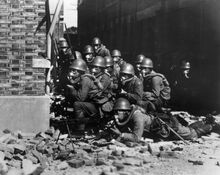
Imperial Japanese Navy marines in action during the Battle of Shanghai
The Second Sino-Japanese War commenced in 1937 between the Japanese Empire and the Republic of China. The Imperial Japanese Army subsequently conquered most Chinese coastal cities, but was bogged down in the interior by determined Chinese resistance.
By 1941, the Japanese had been struggling to conquer the entire Republic of China for four years with little progress. The Japanese war effort was heavily reliant on imported oil. Realising this fact, the United States, the British Empire and the Netherlands imposed an oil embargo on the Japanese Empire in 1940.

Warplanes of the Imperial Japanese Navy bombed Pearl Harbor, a major United States Navy base in Hawaii, on 7 December 1941. This attack dragged the United States into World War 2.
The Japanese, short of oil, then decided to conquer American, British and Dutch territories in Southeast Asia to gain oil reserves. Simultaneously, the Imperial Japanese Navy Air Service would devastate the United States Navy stationed at Pearl Harbor, Hawaii to deter decisive American intervention.
In addition, the Japanese had been sending and recruiting spies all over British Malaya. These Japanese spies were often disguised as local Chinese, although a few British officers also covertly gave information to the Japanese, such as Captain Patrick Heenan in Singapore.
British Empire[]
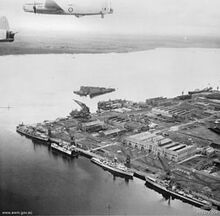
A view of the Singapore Naval Base
Even though the Japanese Empire was an ally of the British Empire during World War 1, by the 1930s, the British were deeply suspicious of Japanese intentions in Asia, as well as Japanese military might. Thus, the British Royal Navy adopted the Singapore strategy, in which a Royal Navy fleet would be based in Singapore to protect British India and Australia from any potential Japanese assault. To that end, the world's largest dry dock at the time, the Singapore Naval Base, was opened in 1938.
However, by 1941, the British had been complacent about their strategy in the East. The Singapore strategy hinged upon the assumption that there would be sufficient warning about an impending Japanese attack and that decisive American help, through the United States Navy base at Pearl Harbor, would be forthcoming. Consequently, there were insufficient land and air forces defending northern Malaya, as the overriding strategy of defending Singapore necessitated the deployment of more forces to the south.

The Royal Air Force and the Royal Australian Air Force stationed in Butterworth were armed with the obsolete Brewster Buffaoes.
In a conference between British and Australian officers in 1941, it was estimated that the air defence of Burma and Malaya required 582 aircraft; on 7 December, there were only 158 aircraft in the entire British Malaya. 110 of these were stationed in northern Malaya, including Butterworth. Most of these aircraft were of obsolete models, such as the Brewster F2A Buffaloes, which were clearly outmatched and outgunned by the Mitsubishi A6M Zeroes used by the Imperial Japanese Navy.
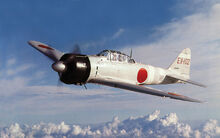
In contrast, the Imperial Japanese Navy had hundreds of Mistubishi A6M Zeroes. The Zeroes were among the most feared Japanese warplanes of World War 2, due to their agility, maneuverability and speed.
In addition, the British high command believed that the forested and mountainous terrain of the Malay Peninsula made it impossible to deploy tanks in Malaya. As a result, when the Imperial Japanese Army began attacking British Malaya, only the British Indian Army had over 20 light tanks, all of which were ill-suited for armoured warfare.
In any event, the United Kingdom itself was threatened by Nazi Germany after the Nazi's conquest of France in 1940. The British, already fighting for their very own survival during the ensuing Battle of Britain, could spare little for the defence of their Eastern colonies. Furthermore, both the then British Prime Minister, Winston Churchill, and the then U.S. President, Franklin D. Roosevelt, agreed that the war in Europe must be given priority.
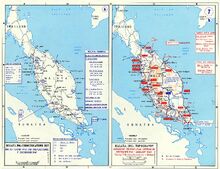
The map to the left depicts the deployment of British and Commonwealth forces in Malaya. The map to the right shows the stages of Japanese advance throughout the Malayan campaign between December 1941 and February 1942.
Initial Planning[]
The Imperial Japanese Army allocated their 25th. Army to the conquest of British Malaya. The 25th. Army, led by Lieutenant-General Tomoyuki Yamashita, consisted of :
- 5th. Division
- 18th. Division
- Imperial Guards Division
- 3rd. Air Division
- 22nd. Air Flotilla
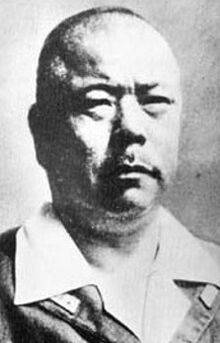
Lieutenant-General Tomoyuki Yamashita, commander of the Imperial Japanese 25th. Army in Malaya. He was later known as the 'Tiger of Malaya' for his exploits.
Among these units, the 5th. Division was tasked to land on southern Thailand, violating Thai neutrality in the process, before proceeding south along the western coast of the Malay Peninsula, including Penang. The 18th. Division, meanwhile, was to assault the northeastern tip of British Malaya and advance down the eastern coast of the Malay Peninsula.
The Imperial Japanese Navy also supported the Army by providing sea transportation for the separate amphibious assaults and close air support. Notably, the Imperial Japanese Navy Air Service sank the British Royal Navy warships, HMS Prince of Wales and HMS Repulse, on 10 December.
The western and eastern prongs of the Imperial Japanese Army would converge at the southern tip of the Malay Peninsula and attack Singapore after an estimated 100 days.
Order of Battle in Penang[]
Imperial Japanese Army[]
- 5th. Division
- Kobayashi Batallion
- 3rd. Air Division
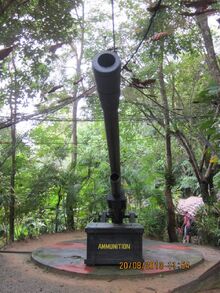
Batu Maung Fort, built by the British in the 1930s, now serves as the Penang War Museum.
Allies[]
The Allied garrison of Penang, commanded by Brigadier C.A. Lyon, was mostly stationed in the Batu Maung Fort (now Penang War Museum). The fort, which was built by the Royal Engineers in the 1930s, was designed to defend both Penang Island and the Royal Air Force base in Butterworth on the Malay Peninsula. Penang Island was subsequently declared a 'fortress' in 1936.
However, by 1941, only two 6-inch batteries were installed. Crucially, no anti-aircraft defences were completed.
In addition, the Royal Air Force base in Butterworth housed squadrons of the Royal Air Force and the Royal Australian Air Force. These squadrons were mostly armed with Brewster Buffaloes.
The Penang and Province Wellesley Volunteer Corps were the reserve forces on Penang Island and were assigned to defend the beaches. However, the unit was poorly trained and equipped.
British Indian Army[]
- 3rd. Corps
- Fortress HQ and Signals
- 11 Coast Regiment Hong Kong and Singapore Royal Artillery
- 36 Fortress Company Royal Engineers
- 5/14th. Punjab Regiment
Straits Settlement Volunteer Force[]
- 3rd. Batallion Penang and Province Wellesley Volunteer Corps
Air Forces[]
- Royal Air Force
- Royal Australian Air Force
Air Battle over Penang[]
On 8 December 1941, the Imperial Japanese Armed Forces began amphibious assaults on southern Thailand and British Malaya, while simultaneously crippling the United States Navy at Pearl Harbor, Hawaii. On that day itself, over half of the 110 Royal Air Force aircraft defending northern Malaya were destroyed.
The following day, the 3rd. Air Division of the Imperial Japanese 25th. Army began the first of the numerous air raids on Penang Island. At 0700 hours, air raid sirens were sounded for the first time, as eight Japanese fighters strafed the Bayan Lepas airport.
During the raid, the Japanese actually placed more effort in neutralising the Royal Air Force and the Royal Australian Air Force stationed in Butterworth. Four British and Australian Brewster Buffaloes scrambled to intercept the Japanese, but in vain. Outmaneuvered and outgunned, the Japanese downed the four Buffaloes and immediately started to bomb the airbase, as well as the nearby oil tanks.
At both airfields, Japanese bombers dropped fragmentation and anti-personnel bombs; these were deadly against men and machines, but intentionally left the runways untouched. The Japanese intended to use the runways once they had been taken.
With the Allied threat wiped out, the Japanese continued by strafing and bombing ships near the Port of Penang in George Town. For the next two days, the Japanese pilots tried to sink ships off Penang Island, without much success.
It was immediately clear from the onset that the Allies were caught unprepared. A British serviceman in Glugor Barracks commented that 'the only anti-aircraft gun available is one Lewis gun, and that stops about every five rounds'.
By 11 December, the Japanese gained air supremacy above Penang Island. Although the Royal Air Force continued to send reinforcements to Butterworth, the Buffaloes could not hold for long. The last Royal Air Force Buffalo barely escaped on 15 December and flew south. However, the worse was yet to come.
Bombing of George Town[]
Previously, the civilians in George Town were left largely alone. This ended on 11 December, when the Japanese bombed George Town for the first time.
According to the Straits Times,
'26 Japanese aeroplanes flew over the island in perfect V formation in groups of three. Instead of sheltering, thousands of people remained in the streets and watched. The enemy circled back over the town, and in successive waves three times dive-bombed the Chinese quarter of George Town. Immediately afterwards they returned, machine-gunning people in the streets, who ran for shelter. There were many casualties. For nearly two hours the enemy maintained this attack, and many buildings in the Chinese quarter were left blazing.'
The report described the lack of preparedness among the civilian population, who had gotten used to listening to air raid sirens and watching the air battles of the previous days, believing that they would be left untouched.
In addition, the raid destroyed the central fire station at Beach Street. Civil servants and policemen fled their jobs, and joined civilians fleeing George Town towards Penang Hill and the 'kongsi' estates in Air Itam. In the aftermath, the Penang General Hospital also had to deal with thousands of casualties.
The Japanese kept up their indiscriminate bombing of George Town for the next 10 days, creating mass panic in the town, and destroying any semblance of law and order. The swift collapse of the authorities allowed criminals and looters to roam freely downtown. Meanwhile, the British Broadcasting Corporation (BBC) was at pains to hide this debacle, choosing to highlight the few successes British and Commonwealth forces had and maintaining the official propaganda of an eventual British victory over the Japanese.
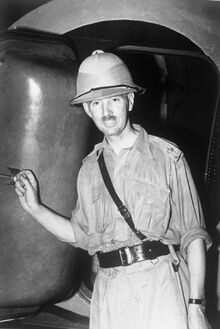
Lieutenant-General Arthur Percival, the commanding officer in British Malaya during the Japanese invasion
British Withdrawal[]
The situation on the Malay Peninsula continued to deteriorate with each passing day. After winning the Battle of Jitra, the Japanese Imperial Army continued their unstoppable advance down through the neighbouring Sultanates of Kedah and Perak.
By 13 December, Lieutenant-General Arthur Percival, the General Officer Commanding Malaya, began to consider withdrawing British and Commonwealth forces on Penang Island, thereby leaving George Town and the island to the Imperial Japanese Army. According to Percival,
'We had the choice of trying to fight the enemy both on the mainland and on Penang Island or of concentrating out resources for the battle on the mainland. The anchorage was no longer of use to us.'
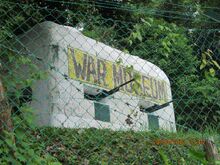
A pillbox within the Penang War Museum, formerly Batu Maung Fort
However, as the bulk of submarine cables at the time passed through Penang Island towards British India, the island still had some strategic importance. Percival ordered the 3rd. Indian Corps to 'use any part of the garrison at Penang that can be made available to take part in Kedah operations' and 'to evacuate Penang removing by sea the garrison and such essential stores as possible', bearing in mind that the defence of Penang Island depended on the defence of Kedah.
On this basis, most of the British and Commonwealth troops on Penang Island were transferred to the Malay Peninsula by 15 December. Before evacuating, the soldiers manning the Batu Maung Fort destroyed the 6-inch guns to deny their use by the Imperial Japanese Army.
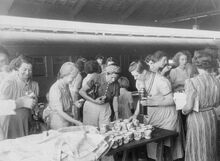
European women sharing tea while being evacuated from Penang Island to Singapore by train in December 1941.
Evacuation of Europeans[]
Also on 13 December, the Governor of the Straits Settlements, Sir Shenton Thomas, ordered the evacuation of the European community on Penang Island. That night, women, children and the disabled were quietly gathered and taken by ferry to Butterworth, before boarding the train to Singapore.
Although the local members of the Penang and Province Wellesley Volunteer Corps were also offered the opportunity to follow their British colleagues out of Penang Island, only one took the offer. It was simply not possible for them as the evacuation of their families was not guaranteed by their British superiors.
This act of racial discrimination eventually led to the loss of British prestige and sense of invulnerability. Historians argued that "the moral collapse of British rule in Southeast Asia came not at Singapore, but at Penang".
Penang Service Committee[]
While Penang Island fell into total chaos and lawlessness as a result of the British withdrawal, a group of civil leaders, doctors and professionals, led by Saravanamuthu, met up to establish the Penang Service Committee on 18 December. It was thought that a semblance of law and order should be restored by the local Asian community leaders themselves.
The first decision made by the committee was to bring down the Union Jack flying at The Esplanade and replacing it with the white surrender banner. Released Japanese civilian detainees were then enlisted to write out messages in Japanese on large cloths, so as to be visible from the air. Saravanamuthu also put the only radio station on Penang Island to use, transmitting an appeal over the radio to the Imperial Japanese Army to cease their aerial bombardment of Penang Island.
"This is Penang calling. Penang calling the Japanese Headquarters in North Malaya. Penang has been evacuated by the British. There are no more troops or any defences whatsoever in Penang. Please refrain from bombing Penang."
Fall of Penang Island[]
Imperial Japanese Army's Kobayashi Battalion, veterans of the war in China, made a formal landing at the Church Street Pier on 19 December. The 1,000-strong battalion then fanned out across Penang Island and found George Town to be deserted, with most civilians hiding in rural areas like Air Itam.
One of the first acts of the battalion was the rounding up of Chinese youths hiding in makeshift refugee camps in Air Itam. The teenagers were then marched off into prison, where they remained until their relatives could secure their release with promises of good behaviour.
There were also instances of rape by the men of the battalion. Upon learning of the rape cases, however, Lieutenant-General Tomoyuki Yamashita ordered the court-martial of those involved.
The Japanese soldiers also took control of the only radio station on Penang Island, using it to broadcast a chilling message - "Hello, Singapore, this is Penang calling. How do you like our bombing?".
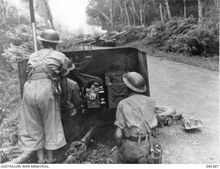
Australian Army soldiers manning an anti-tank gun in southern Malaya in January 1942. Eventually, all British and Commonwealth forces were withdrawn to Singapore by 31 January 1942.
Aftermath[]
The landing of the Kobayashi Battalion on Penang Island on 19 December marked the start of the Japanese occupation of Penang, which would last for more than 3 years and 8 months. This brutal period was marked by racially-motivated massacres known as Sook Ching and severe economic hardship. Women were also taken away to be used as comfort women by the Imperial Japanese Army.

British Army soldiers in Singapore surrendering to Imperial Japanese Army troops on 15 February 1942.
The Imperial Japanese Army would go on to capture Singapore on 15 February 1942. It was considered the biggest British military defeat of all time, so much so that even Churchill described it as 'the worst disaster and largest capitulation in British history'.

Malay and Chinese ladies on Penang Island were taken as comfort women by the Imperial Japanese Army.
In 1944, as World War 2 was nearing its end, the British Royal Air Force and the United States Army Air Force stationed in British India commenced air raids on Penang. The Allied bombardment proved to be more destructive; the destruction of the Penang Secretariat building caused the loss of the greater part of the British and Japanese records concerning Penang Island, and several examples of colonial architecture were destroyed for good.
The Japanese would continue to occupy Penang Island until 3 September 1945, when the British Royal Marines retook the island under Operation Jurist. However, the humiliating British defeat, coupled with the swift evacuation of British soldiers and European civilians, discredited the British themselves in the eyes of the local population.
References[]
- Barber, A., 2010. Penang At War : A History of Penang During and Between the First and Second World Wars 1914-1945. AB&A.
- Cooper, B.C., 1998. Decade of Change : Malaya and the Straits Settlements 1936 - 1945. Graham Brash, Singapore.
- http://eresources.nlb.gov.sg/infopedia/articles/SIP_2013-07-19_162143.html
- http://eresources.nlb.gov.sg/infopedia/articles/SIP_1820_2011-07-19.html
- http://www.fepow-community.org.uk/arthur_lane/Percivals_Report/html/withdrawal_from_nth___malaya.htm
- http://ww2db.com/battle_spec.php?battle_id=47
- http://www.mindef.gov.sg/imindef/publications/pointer/monographs/mono6/_jcr_content/imindefPars/0005/file.res/Malayan%20Campaign.pdf
- http://news.bbc.co.uk/onthisday/hi/dates/stories/february/15/newsid_3529000/3529447.stm
- http://www.penang-traveltips.com/penang-war-museum.htm
- http://anilnetto.com/society/malaysian-history/old-penang-the-sook-ching-massacres-of-world-war-ii/